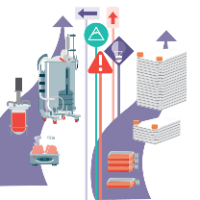Stabilizing DNA–PEI complexes improves scalability of suspension lentiviral viral vector and AAV processes
Cell & Gene Therapy Insights 2022; 8(8), 985–992
DOI: 10.18609/cgti.2022.146
Transient transfection is a challenging and time-sensitive upstream unit operation to scale for suspension HEK293 viral vector production. For many transfection reagents, including polyethyleneimine, careful timing of mixing and hold steps is essential to process performance but challenging to maintain at relevant manufacturing scales. We first characterized the process parameters that influence polyethyleneimine transfection reagent performance and then implemented a stabilizing strategy to preserve the activity of transfection complexes when scaling. Generating a transfection complex with an average hydrodynamic diameter between 500 and 700 nm was most predictive of transient transfection productivity, measured by viral vector titer, but is very sensitive to transfection complex concentration and hold time. The addition of human serum albumin as a stabilizing agent maintained the optimal transfection complex size for extended periods of time and improved the process control for both lentiviral vector and adeno-associated viral vector suspension processes at multiple production scales.
